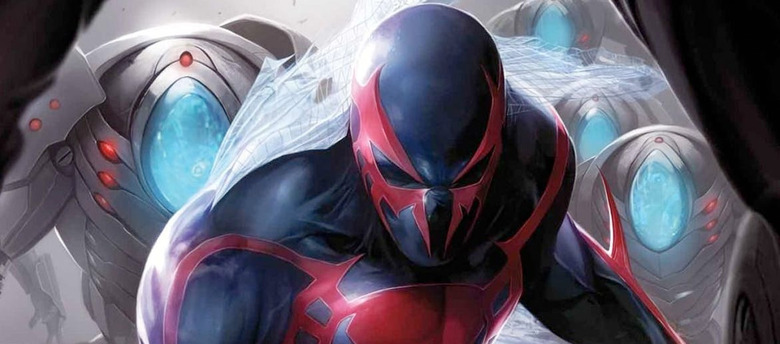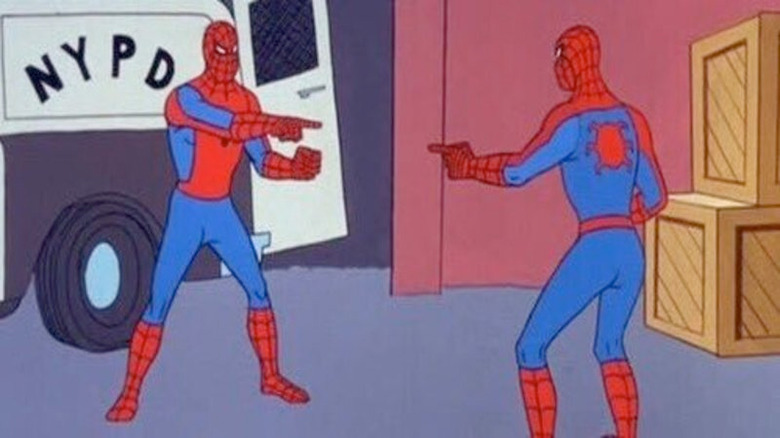What Is That 'Spider-Man: Into The Spider-Verse' Credits Scene All About?
Spider-Man: Into the Spider-Verse is a superhero movie, so it should come as no surprise that it has a post-credits scene that sets the stage for future installments of the animated Spider-Verse. However, if you're only a casual Spider-Man fan, you might have been confused about how the scene unfolded and exactly what was going on. But don't worry, we explain the Spider-Man Into the Spider-Verse credits scene in detail below.
First of all, let's set the stage as to how this post-credits comes to be within the narrative of Spider-Man: Into the Spider-Verse, especially if you're choosing to read this story and haven't seen the movie yet.
Into the Spider-Verse finds Kingpin (Liev Schreiber) trying to use a particle collider to tap into parallel dimensions in an effort to bring a different version of his wife and son into his own dimension so he can be reunited with them. Kingpin's wife and son left him when they saw him fighting Spider-Man and realized that he wasn't a good guy.
However, the particle collider ends up creating some complications and brings elements of the other dimensions into the New York City occupied by Miles Morales (Shameik Moore). That's how the alternate version of Peter Parker as Spider-Man (Jake Johnson), Spider-Gwen (Hailee Steinfeld), Spider-Ham (John Mulaney), Peni Parker (Kimiko Glenn), and Spider-Man Noir (Nicolas Cage) come to be in the presence of Miles Morales. Complications from the dimensions merging partially result in the transferred Spider-People facing the prospect of disintegrating unless the rift in the dimension is closed by properly shutting down the collider once and for all.
While Into the Spider-Verse has a happy ending, sending all of the dislocated Spider-People back to their own universes, there's one who only experiences this rift between dimensions from a distance, and that's who we meet in the post-credits scene.
Spider-Man 2099 is Watching
After all the credits have rolled, a comic bubble appears saying "Meanwhile, in Nueva York..."
A scientist sort of woman appears on screen and she's talking about the dimension-hopping that just unfolded in the movie, speaking to a character off-screen named Miguel. Suddenly, that character appears, and it's another version of Spider-Man that the bigger webslinger fans will immediately recognize.
That's Miguel O'Hara, better known as Spider-Man 2099, and in this post-credits scene, he's voiced by Oscar Isaac (Star Wars: The Last Jedi, Ex Machina). He's wearing his traditional red and blue suit with a much more prominent and unique spider logo design and a face looking more like a luchador than the traditional Spidey mask.
This futuristic version of Spider-Man first debuted in 1992 as part of an overarching Marvel comic series that took place in the year 2099. Miguel was a geneticist working at the Alchemax Corporation, which just so happens to be the same company at the center of the particle collider project in Into the Spider-Verse. In the comics, he's tricked into taking a highly addictive drug so that he won't leave the company, so he tries to cure himself by rewriting his own genetic code. Unfortunately, a co-worker sabotages him, resulting in him receiving spider DNA and becoming the future's new Spider-Man.
The presence of Spider-Man 2099 could be a big deal for the future of Spider-Man: Into the Spider-Verse since it might allow for another Spider-Person to pop up in Miles' version of New York City, especially since the barrier between dimensions is open enough to allow Gwen Stacy to pop her head into Miles' bedroom at the very end of the movie. And with Spider-Man 2099's origins being tied to Alchemax Corporation, there could be a sequel story making the future Spider-Man a key player.
But this post-credits scene isn't concerned with that for now. Instead, they used Spider-Man 2099 for a funny gag.
Spider-Man Double Identity Crisis
If you've been on the internet at all, you know that there are several memes featuring the original 1967 animated series adaptation of Spider-Man. But perhaps the most famous is the image of two Spider-Men pointing at each other in a warehouse from an episode called "Double Identity."
In the post-credits scene, Spider-Man 2099 says he's going back to "the beginning" in order to partake in his own dimension-hopping story, and he makes a jump to Earth-67, where he becomes part of this famous scene. Spider-Man 2099 and the original animated Spider-Man point at each other and keep trying to convince they other that they're the real Spider-Man.
It's a hilarious gag that doesn't really mean anything in the overall scheme of things, but the fact that Oscar Isaac is voicing the character likely means that Spider-Man 2099 won't just be used for a quick joke after the credits. Plus, the reason Spider-Man 2099 is able to jump into another dimension like this is because he has a watch that allows him to pass through different dimensions. That technology could be used to allow other Spider-People to jump dimensions, and the possibilities are endless as to what the sequels to Into the Spider-Verse could do next.
Spider-Man: Into the Spider-Verse is in theaters now, and a sequel is already in the works.


